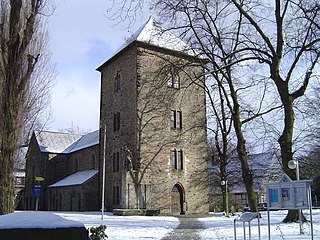
Herford is a town in North Rhine-Westphalia, Germany, located in the lowlands between the hill chains of the Wiehen Hills and the Teutoburg Forest. It is the capital of the district of Herford.

The Evangelical Church in Germany is a federation of twenty Lutheran, Reformed (Calvinist) and United Protestant regional churches and denominations in Germany, which collectively encompasses the vast majority of Protestants in that country. In 2019, the EKD had a membership of 20,713,000 members, or 24.9% of the German population. It constitutes one of the largest national Protestant bodies in the world. Church offices managing the federation are located in Hannover-Herrenhausen, Lower Saxony. Many of its members consider themselves Lutherans.

The German Evangelical Church was a successor to the German Evangelical Church Confederation from 1933 until 1945.

Gütersloh is a city in North Rhine-Westphalia, Germany, in the area of Westphalia and the administrative region of Detmold. Gütersloh is the administrative centre for a district of the same name and has a population of 100,194 people.

Radevormwald is a municipality in the Oberbergischer Kreis, in North Rhine-Westphalia, Germany. It is one of the oldest towns in the Bergischen Land, formerly the County and Duchy of Berg.

The Bethel Foundation, officially the Bodelschwingh Foundation Bethel is a diaconal psychiatric hospital in Bethel, formerly a town, today a neighbourhood of Bielefeld, Germany.

The Prussian Union of Churches was a major Protestant church body which emerged in 1817 from a series of decrees by Frederick William III of Prussia that united both Lutheran and Reformed denominations in Prussia. Although not the first of its kind, the Prussian Union was the first to occur in a major German state.

The Protestant Church of Westphalia is a United Protestant church body in North Rhine-Westphalia.

Wolfgang Huber is a prominent German theologian and ethicist. Huber served as bishop of the Evangelical Church of Berlin-Brandenburg-Silesian Upper Lusatia until November 2009. Huber succeeded Manfred Kock as Chairperson of the Council of the Evangelical Church in Germany (EKD) in November 2003 and was succeeded by Bishop Margot Käßmann, the first woman in that position, in October 2009.

Hans Philipp Ehrenberg was a German Jewish philosopher and theologian. One of the co-founders of the Confessing Church, he was forced to emigrate to England because of his Jewish ancestry and his opposition to Nazism.
Paul Althaus was a German Lutheran theologian. He was born in Obershagen in the Province of Hanover, and he died in Erlangen. He held various pastorates from 1914 to 1925, when he was appointed associate professor of practical and systematic theology at the University of Göttingen, becoming full professor two years later. Althaus was moderately critical of Lutheran Orthodoxy and evangelical-leaning Neo-Lutheranism. He termed it a “mistake” to “defend the authenticity and infallibility of the Bible.”

Trinity Church (Dreifaltigkeitskirche) was a Baroque Protestant church in Berlin, eastern Germany, dedicated to the Holy Trinity. It was opened in August 1739 and destroyed in November 1943, with its rubble removed in 1947.

The Christuskirche is a church and parish of German Protestants in Paris. Initially founded as a Lutheran church is it today a United church. The present building was completed in 1894. The official name is Deutsche Evangelische Christuskirche – Église protestant allemande à Paris. The church is a member of the Evangelische Kirche in Deutschland (EKD). It has a tradition as a concert venue of church music, with Helga Schauerte as the organist from 1982.

St. Peter is a Romanesque church in Syburg, now a suburb of Dortmund, Germany. It is the active Protestant parish church of Syburg, officially named "Ev. Kirche St. Peter zu Dortmund-Syburg". It serves as a concert venue for the bimonthly Syburger Sonntagsmusiken.

Hans Joachim IwandGerman: [haːns joːaxɪm iːvaːnd] was a German Lutheran theologian. Iwand's thought was considerably influenced by Karl Barth.
Helmut Kahlhöfer was a German church musician and academic teacher. He was the founder and for decades the conductor of the choir Kantorei Barmen-Gemarke.

Aplerbeck is a village in Germany first documented in 899. Since 1929, it has been a suburb (Ortsteil) of Dortmund in the Ruhr district of North Rhine-Westphalia, located in the city's south-east. The river Emscher, a tributary of the Ruhr, crosses Aplerbeck.

The Große Kirche Aplerbeck is a Protestant church in Aplerbeck, now part of Dortmund, Germany. It was built from 1867 to 1869 in Gothic Revival style, designed by Christian Heyden. A listed monument, it is used by the parish St. Georg, serving mostly as a concert church.

St. Georg is a church and Protestant parish in Aplerbeck, now part of Dortmund, North Rhine-Westphalia, Germany. It is a Romanesque cross basilica (Kreuzbasilika) from the 12th century. The only building in Dortmund of its kind, it is a listed monument.

The Protestant Church in Wilnsdorf, North Rhine-Westphalia, Germany, was completed in 1913. It has been the main church for merged parishes from 2010. The official name of the new parish is Evangelisch-Reformierte Kirchengemeinde Rödgen-Wilnsdorf, The parish is part of the Kirchenkreis Siegen in North Rhine Westphalia.

























